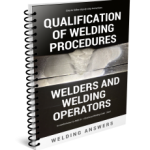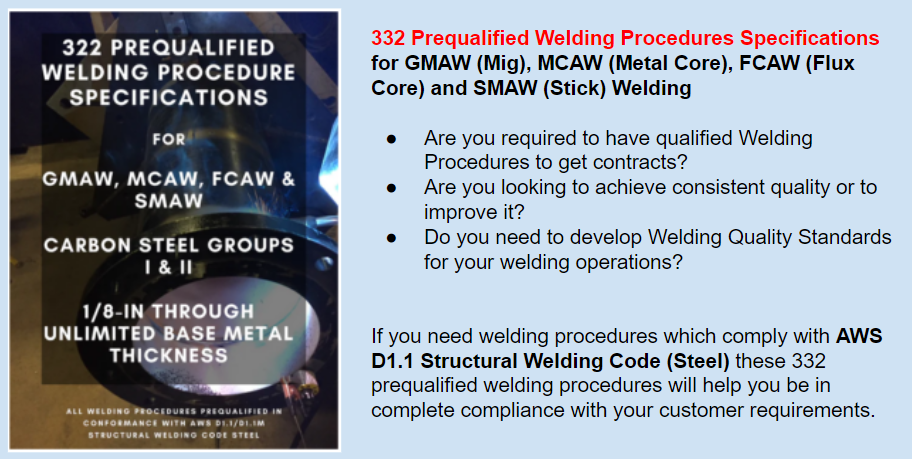
The purpose of having welding procedures specifications (WPS) is to ensure quality. This is accomplished by giving the welder a detailed set of instruction on how to deposit weld metal for a specific joint. Consistent quality can be achieved, but there is one caveat. The welding procedures must be well written. A poorly written welding procedure can be as bad, or worse, than having no welding procedures at all. Other than ensuring quality a welding procedure can have a significant impact (and it usually does) on productivity.

A properly developed Welding Procedure Specification should specify allowable ranges for all essential variables.
Welding procedures are the foundation of any welding quality management system. So why is it that many welders don’t follow them? Here are the top 11 reasons we run into in the field as to why welders do not follow WPSs. These are not in any particular order.
Reason #1: There are no welding procedures specifications. As important as it is to have written WPSs most fabricators don’t have them.
Reason #2: They are not given a copy at their station. This is very common at fab shops where welding procedures specifications are only developed to satisfy a customer requirement. Copies of these WPSs are kept on file at the front office and never make it out the welders. The welders are left with no choice but to select whatever welding parameters they feel are best.
Reason #3: Following the WPS creates problems. This can be spatter, an inconsistent arc, cold lap, burn through and many other problems. This is a sign of a poorly written WPS. The welder then has to make adjustments that puts him or her outside of the ranges allowed by the welding procedures in order to deposit a good weld.
Reason #4: The welding equipment is faulty. A well written WPS will have tight ranges for different variables such as amperage, voltage, travel speed, etc. However, if the equipment is in disrepair and the welder is experiencing problems such as voltage drop, he or she will be forced to adjust the equipment. Chances are the arc voltage will be within range, but the welding machine will be reading something much higher. Inspectors will not measure your arc voltage, they will take the machine reading. They may go a step further and measure the output at the studs, but this does not account for voltage losses in the welding lead or work cable.
Reason #5: The welder wants to increase productivity. We are yet to walk into a shop where a welder is told to take his time, weld as fast or slow as desired, and to not worry if the daily quota is not met. A welding procedure will dictate your maximum deposition rate, the rate at which you deposit weld metal. This deposition rate has a huge bearing on productivity. A welding procedure limits this so it limits how fast something can be welded. In order to speed up, welders have to make changes that put them outside of the welding parameters set in the WPS.
Reason #6: Welders know better. They may actually know how to develop a better welding procedure; however, being in violation of a WPS is never good. Some welding procedures have limits to comply with the rules and requirements of a prequalified welding procedure specification. Others have limits to prevent excessive heat input (or not enough). Others have limits that make no sense. When a welder increases his parameters because the ones on the WPS seem to hamper production, he or she may be exceeding or not meeting other requirements. The welder is trying to help, but this can create a violation of welding procedures.
Reason #7: They have never had a failure. We see this a lot. A shop finally decides to develop WPSs and get them implemented. The welder may be used to running parameters which are not allowed by the new WPS. Since the welder has never had any problems with his or her own procedures they opt to disregard the WPS.
Reason #8: Management does not enforce the WPSs. This is very common too. A WPS may be in place but management dare not mess with the welders. They depend so heavily on the welders that they don’t want to rock the boat. This problem arises from the lack of understanding of the welding process by people running the company.
Reason #9: Management does not provide adequate training and/or information as to why the WPS must be followed. If welders are told a compelling reason as to why they should always abide by the WPS provided they typically will. However, in some shops the welders believe the WPS is simply a recommendation or a starting point, not a requirement.
Reason #10: The welder makes a change to an essential variable. A welder may be running wire feed speed, voltage, contact tip to work distance, travel angle and work angle all according to the WPS. But instead of welding vertical up he or she welds vertical down. Unless there is a separate WPS for this change in weld progression the welder would be in violation of the WPS. Whatever code or standard has been followed for the development of a WPS will have a list of changes to essential variables that would require WPS requalifiction.
Reason #11: The welding machine is not capable to run procedures called for in the WPS. If a WPS calls for .045” ER70S-6 GMAW wire at 450 inches per minute wire feed speed and a contact tip to work distance of ¾-in, the resulting current will be about 310-330 amps. If the welder has to use a Millermatic 252 he cannot get to this current, period.
In many cases it takes an audit, the loss of a contract, or a catastrophic failure for management to realize the importance of developing sound welding procedures and implementing them in their shop. Don’t wait for that to happen. Look into your welding procedures, if any, and how they are being followed (or not) in your shop today.
____________________________________________________________________
Are you looking to qualify welding procedure and/or welders? Are you using AWS D1.1 Structural Welding Code -Steel as your quality standard?
 “Qualifying Welding Procedures, Welders and Welding Operators” is a guide developed to help you perform your own qualifications in full compliance to AWS D1.1 Structural Welding Code. It provides step-by-step instructions on how to qualify welders and welding procedures. It also provide step-by-step instruction on the proper use of prequalified welding procedures.
“Qualifying Welding Procedures, Welders and Welding Operators” is a guide developed to help you perform your own qualifications in full compliance to AWS D1.1 Structural Welding Code. It provides step-by-step instructions on how to qualify welders and welding procedures. It also provide step-by-step instruction on the proper use of prequalified welding procedures.


I think it’s great to learn the welding procedures.